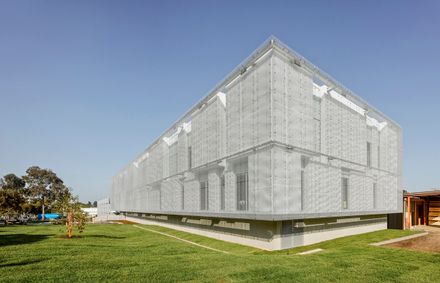
Agilent Technologies
QUANTITY SURVEYOR
Dcw
PROJECT ARCHITECT
Anna Maskiell
MECHANICAL SERVICES
Skm
CONTRACTOR
Wilkore
PROJECT MANAGER
Dcwc
ELECTRICAL SERVICES
Skm
DOCUMENTATION
Peter Blair, Ashley Fraser, Tom
ACOUSTIC
Marshall Day Acoustics
BUILDING SURVEYOR
Plp
DDA CONSULTANT
Architecture & Access
TECHNICAL SUPPORT
David Fletcher
PROJECT DIRECTOR
Andrew Kings
HYDRAULIC SERVICES
Cr Knight & Associates
WORKPLACE STRATEGY + PROJECT DIRECTOR
Philip Ward
STRUCTURAL + CIVIL ENGINEERING
Bonacci Group
LOCATION
Mulgrave, Australia
CATEGORY
Research, Institutional Buildings
Agilent Technologies wanted us to design a built environment that would change how their people work: to help them invent, test and refine ideas more consistently and quickly.
They also wanted the building to represent spectroscopy – the study of light. Every aspect of the STIC – the spatial qualities, façade design, detailing, furniture specification, lighting and even ventilation design – has been designed to disrupt ‘business as usual’ and provoke innovation.
The building is a series of micro-environments for thinking, testing, knowledge sharing and production; wrapped in a ‘veil’ that offers constantly shifting experiences of light and shadow to employees, collaborators and the public.
The design reflects Agilent Technologies’ team sizes, disciplinary mix and organizational culture. The multi-layered, habitable facade creates alcoves for small team and individual work.
The open-plan research space is gently divided into small neighbourhoods by the careful placement of pods which are technologically rich environments for virtual teaming, stand up meetings, small group work or focussed individual production.
Directly adjacent and visually connected to the open-plan research spaces are a series of highly flexible laboratory environments. The bespoke adaptable furniture and servicing systems can be transformed as inventions develop; transferred to specialist laboratories for testing; and even come into the workplace where safety allows. The ‘Town Square’ is the social heart of the building and connects it to the broader campus.
Containing a museum stair, cafe, sunken courtyard, Gen-Y space and clustered formal and informal meeting spaces, the Town Square employs a more richly textured material palette and geometry than the research spaces to create a sense of permanence and monumentality.
Within the three-storey volume there are small spaces for individuals and groups to collaborate, relax and meet whilst also offering a rich social space for the entire campus to come together to celebrate past and future successes.












